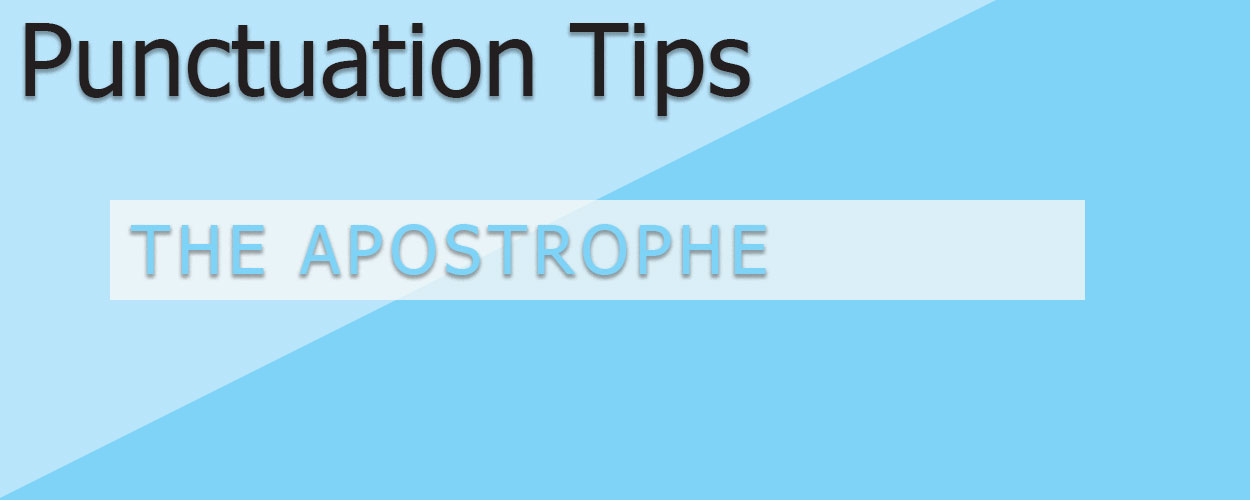Posted: February 9, 2023
Definition: a punctuation mark (’) used to indicate either possession (e.g., Harry’s book; boys’ coats) or the omission of letters or numbers (e.g., can’t; he’s; class of ’99).
Note: Do not rely on grammar or spelling checkers to identify missing or misused punctuation. Although a checker may flag possibly missing or incorrect marks, it cannot do much else. While I still recommend using these AI checkers while you’re writing, I insist that you also trust a qualified human being to copyedit any work that you are working toward publishing.
An apostrophe has three main uses: to form certain plurals, to form contractions, and to indicate possession. Unlike single quotation marks, apostrophes ALWAYS curl to the left. Take care that your apostrophes are facing the right way, as word processing software often doesn’t fix this issue.
To Form Plurals:
Use an apostrophe to make letters and numbers plural.
- e.g. Cross your t’s and dot your i’s.
Use an apostrophe to form the plural of a word used as a word.
- e.g. How many “and’s” can you put in a row with it remaining grammatically correct?
Use an apostrophe to form the plural of an abbreviation.
- e.g. The stray population is so large that the city now has three SPCA’s.
Do not use an apostrophe to form the plural of years.
- e.g. World War II took place in the 1940s.
To Form Contractions:
Use an apostrophe to indicate one or more missing letters in a contraction.
- e.g. There’s nothing I can’t do.
Use an apostrophe to indicate missing numerals in a year.
Use an apostrophe to indicate missing letters in dialogue.
- e.g. “I’m goin’ to the play with ’em, an’ you can’ stop me,” he said.
To Indicate Possession:
Do not use an apostrophe with the pronouns his, hers, its, ours, yours, theirs, and whose.
- e.g. My neighbour’s dog wagged its tail.
Note: Be careful not to confuse its with it’s, you’re with your, or who’s with whose. It’s is always it is or it has, who’s is always who is or who has, and you’re is you are.
Note: To form a possessive with any noun, simply add ’s to the singular. Depending on the dictionary/style guide/personal preference being used, if the singular already ends in s, you may just add the apostrophe (Davy Jones’ Locker), or you may add ’s (Davy Jones’s Locker). To form a possessive with a plural, if the plural ends with s, add an apostrophe (girls’ clothes), and if the plural does not end in s, add ’s (children’s ward).
For double subjects, use the possessive with the second noun only.
- e.g. Fred and George’s Skiving Snack Boxes.
Note: this only applies if both subjects have possession of the same thing. If each subject has it’s own thing, each of them takes an apostrophe.
- e.g. John’s and Henry’s sons. [each man has his own son/sons]
With Other Punctuation:
Apostrophes may be used with any other punctuation as they are self-containing.
- e.g. “Just like back in ’99,” Margo said.
- e.g. Where are you goin’?
- e.g. The boys all wore their uniforms backwards.
- e.g. I can’t believe it’s not butter!
For further information, see my other Punctuation articles:
Sources:
Aaron, J.E. & Morrison, A. The Little, Brown Compact Handbook, 5th Canadian ed. Pearson, 2013, chap 5
Judd, K. Copyediting, A Practical Guide, 3rd ed. California, CA: Crisp Learning, 2001, chap 4

